Input interpretation

(tritylamine)-α-(methoxyimino)-4-thiazoleacetic acid
Basic properties
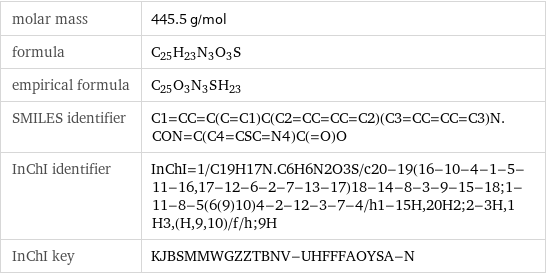
molar mass | 445.5 g/mol formula | C_25H_23N_3O_3S empirical formula | C_25O_3N_3S_H_23 SMILES identifier | C1=CC=C(C=C1)C(C2=CC=CC=C2)(C3=CC=CC=C3)N.CON=C(C4=CSC=N4)C(=O)O InChI identifier | InChI=1/C19H17N.C6H6N2O3S/c20-19(16-10-4-1-5-11-16, 17-12-6-2-7-13-17)18-14-8-3-9-15-18;1-11-8-5(6(9)10)4-2-12-3-7-4/h1-15H, 20H2;2-3H, 1H3, (H, 9, 10)/f/h;9H InChI key | KJBSMMWGZZTBNV-UHFFFAOYSA-N
Structure diagram
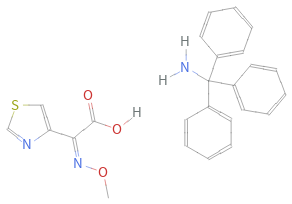
Structure diagram
Quantitative molecular descriptors
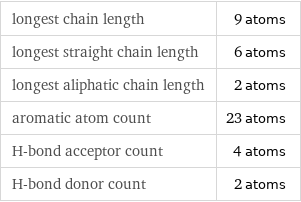
longest chain length | 9 atoms longest straight chain length | 6 atoms longest aliphatic chain length | 2 atoms aromatic atom count | 23 atoms H-bond acceptor count | 4 atoms H-bond donor count | 2 atoms
Elemental composition

Find the elemental composition for (tritylamine)-α-(methoxyimino)-4-thiazoleacetic acid in terms of the atom and mass percents: atom percent = N_i/N_atoms × 100% mass percent = (N_im_i)/m × 100% Plan: • Write the chemical formula and gather atomic masses from the periodic table. • Determine values for N_i, m_i, N_atoms and m using these items. • Finally, compute the percents and check the results. Write the chemical formula: C_25H_23N_3O_3S Use the chemical formula to count the number of atoms, N_i, for each element and find the total number of atoms, N_atoms, per molecule: | number of atoms C (carbon) | 25 O (oxygen) | 3 N (nitrogen) | 3 S (sulfur) | 1 H (hydrogen) | 23 N_atoms = 25 + 3 + 3 + 1 + 23 = 55 Divide each N_i by N_atoms to calculate atom fractions. Then use the property that atom fractions must sum to one to check the work: | number of atoms | atom fraction C (carbon) | 25 | 25/55 O (oxygen) | 3 | 3/55 N (nitrogen) | 3 | 3/55 S (sulfur) | 1 | 1/55 H (hydrogen) | 23 | 23/55 Check: 25/55 + 3/55 + 3/55 + 1/55 + 23/55 = 1 Compute atom percents using the atom fractions: | number of atoms | atom percent C (carbon) | 25 | 25/55 × 100% = 45.5% O (oxygen) | 3 | 3/55 × 100% = 5.45% N (nitrogen) | 3 | 3/55 × 100% = 5.45% S (sulfur) | 1 | 1/55 × 100% = 1.82% H (hydrogen) | 23 | 23/55 × 100% = 41.8% Look up the atomic mass, m_i, in unified atomic mass units, u, for each element in the periodic table: | number of atoms | atom percent | atomic mass/u C (carbon) | 25 | 45.5% | 12.011 O (oxygen) | 3 | 5.45% | 15.999 N (nitrogen) | 3 | 5.45% | 14.007 S (sulfur) | 1 | 1.82% | 32.06 H (hydrogen) | 23 | 41.8% | 1.008 Multiply N_i by m_i to compute the mass for each element. Then sum those values to compute the molecular mass, m: | number of atoms | atom percent | atomic mass/u | mass/u C (carbon) | 25 | 45.5% | 12.011 | 25 × 12.011 = 300.275 O (oxygen) | 3 | 5.45% | 15.999 | 3 × 15.999 = 47.997 N (nitrogen) | 3 | 5.45% | 14.007 | 3 × 14.007 = 42.021 S (sulfur) | 1 | 1.82% | 32.06 | 1 × 32.06 = 32.06 H (hydrogen) | 23 | 41.8% | 1.008 | 23 × 1.008 = 23.184 m = 300.275 u + 47.997 u + 42.021 u + 32.06 u + 23.184 u = 445.537 u Divide the mass for each element by m to calculate mass fractions. Then use the property that mass fractions must sum to one to check the work: | number of atoms | atom percent | mass fraction C (carbon) | 25 | 45.5% | 300.275/445.537 O (oxygen) | 3 | 5.45% | 47.997/445.537 N (nitrogen) | 3 | 5.45% | 42.021/445.537 S (sulfur) | 1 | 1.82% | 32.06/445.537 H (hydrogen) | 23 | 41.8% | 23.184/445.537 Check: 300.275/445.537 + 47.997/445.537 + 42.021/445.537 + 32.06/445.537 + 23.184/445.537 = 1 Compute mass percents using the mass fractions: Answer: | | | number of atoms | atom percent | mass percent C (carbon) | 25 | 45.5% | 300.275/445.537 × 100% = 67.40% O (oxygen) | 3 | 5.45% | 47.997/445.537 × 100% = 10.77% N (nitrogen) | 3 | 5.45% | 42.021/445.537 × 100% = 9.432% S (sulfur) | 1 | 1.82% | 32.06/445.537 × 100% = 7.196% H (hydrogen) | 23 | 41.8% | 23.184/445.537 × 100% = 5.204%
Elemental oxidation states

The first step in finding the oxidation states (or oxidation numbers) in (tritylamine)-α-(methoxyimino)-4-thiazoleacetic acid is to draw the structure diagram. Next set every oxidation number equal to the atom's formal charge: In (tritylamine)-α-(methoxyimino)-4-thiazoleacetic acid hydrogen is not bonded to a metal with lower electronegativity, so it will have an oxidation state of +1. Any element bonded to hydrogen gains the bonding electrons, decreasing their oxidation state by 1 for every bond: With hydrogen out of the way, look at the remaining bonds. There are 4 carbon-nitrogen bonds, 3 carbon-oxygen bonds, 2 carbon-sulfur bonds, 1 nitrogen-oxygen bond, and 24 carbon-carbon bonds. For each of these bonds, assign the bonding electrons to the most electronegative element. First examine the carbon-nitrogen bonds: element | electronegativity (Pauling scale) | C | 2.55 | N | 3.04 | | | Since nitrogen is more electronegative than carbon, the electrons in these bonds will go to nitrogen. Decrease the oxidation number for nitrogen in every highlighted bond (by 1 for single bonds, 2 for double bonds, and 3 for triple bonds), and increase the oxidation number for carbon accordingly: Next look at the carbon-oxygen bonds: element | electronegativity (Pauling scale) | C | 2.55 | O | 3.44 | | | Since oxygen is more electronegative than carbon, the electrons in these bonds will go to oxygen: Next look at the carbon-sulfur bonds: element | electronegativity (Pauling scale) | C | 2.55 | S | 2.58 | | | Since sulfur is more electronegative than carbon, the electrons in these bonds will go to sulfur: Next look at the nitrogen-oxygen bond: element | electronegativity (Pauling scale) | N | 3.04 | O | 3.44 | | | Since oxygen is more electronegative than nitrogen, the electrons in this bond will go to oxygen: Next look at the carbon-carbon bonds: element | electronegativity (Pauling scale) | C | 2.55 | C | 2.55 | | | Since these elements are the same the bonding electrons are shared equally, and there is no change to the oxidation states: Now summarize the results: Answer: | | oxidation state | element | count -3 | N (nitrogen) | 2 -2 | C (carbon) | 1 | O (oxygen) | 3 | S (sulfur) | 1 -1 | C (carbon) | 15 | N (nitrogen) | 1 0 | C (carbon) | 4 +1 | C (carbon) | 2 | H (hydrogen) | 23 +2 | C (carbon) | 2 +3 | C (carbon) | 1
Orbital hybridization
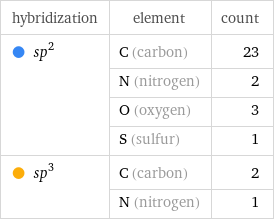
hybridization | element | count sp^2 | C (carbon) | 23 | N (nitrogen) | 2 | O (oxygen) | 3 | S (sulfur) | 1 sp^3 | C (carbon) | 2 | N (nitrogen) | 1
Structure diagram
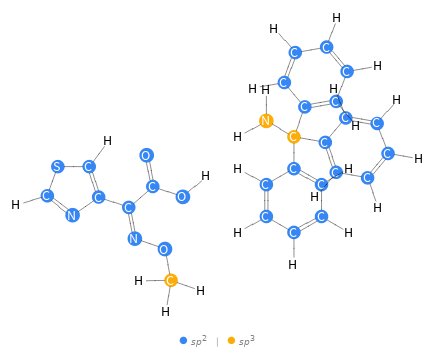
Orbital hybridization Structure diagram
Topological indices
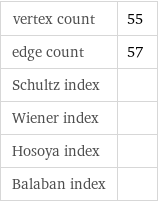
vertex count | 55 edge count | 57 Schultz index | Wiener index | Hosoya index | Balaban index |